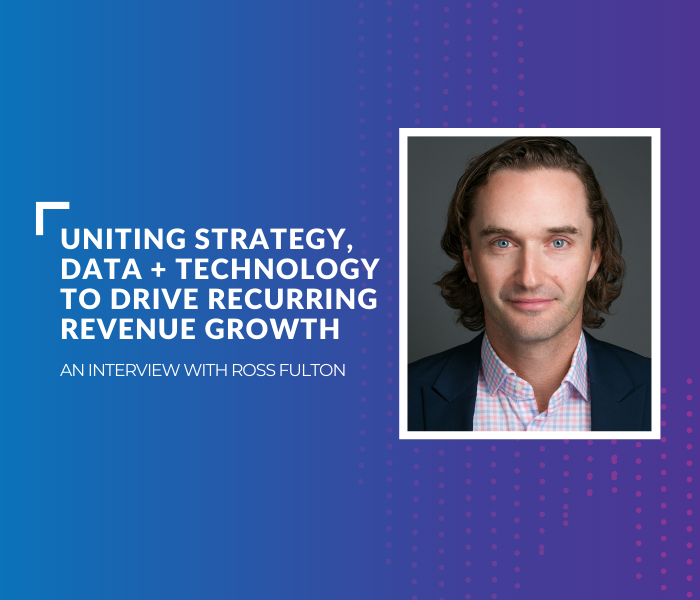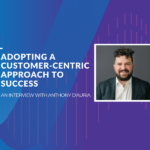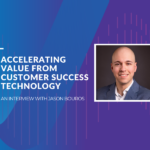Uniting Customer Success Strategy, Data, and Technology
Customer success professionals around the world are celebrating an extraordinary milestone… as of June 2020, 50% of customer success organizations now own the primary responsibility for renewals (TSIA, 2021). This comes as no surprise, as customer success continues to be an essential function for driving the recurring revenue growth of software companies.
With this increasing spotlight on customer success, many C-suite leaders are looking for sharp and innovative ways to support, structure, and accelerate their customer success organizations. A strong trifecta of strategy, data, and technology is the pinnacle to this success.
To dive deeper into this concept, I sat down with Ross Fulton, Founder and CEO of Valuize. Ross oversees the strategic, operational and organizational development of customer success functions for industry-leading B2B software companies including Splunk, VMWare, Hashicorp, and Datto. During our conversation, Ross shares his deep passion for and wisdom about how today’s customer and revenue leaders can successfully unify customer success strategy, data and technology to drive recurring revenue growth at scale.
An Interview With Ross Fulton, Founder & CEO Of Valuize
Q: What was your first job?
A: “My first job was selling sneakers in a sports store in London. It was my first real venture in sales, and the experience helped me develop a natural instinct for selling based on the value that can be realized from a product. I was the top-selling sales person for a couple years while I worked there and owned way too many pairs of sneakers!”
Q: How did you get started in customer success?
A: “I got started long before the term ‘customer success’ was established. In 2005, I was given an opportunity to help build a performance-based (gainshare) revenue model business unit for one Europe’s largest technology companies. The business model was all about ensuring our customers realized measurable value from our service because that’s how my company earned revenue. The customer value or ‘gain’ was in the form of verified $ savings that we enabled our customers to achieve and my company took a share of those $ savings. I ran both pre and post sales for that business and turned it into a 9-figure revenue generating unit.”
“Fast-forward to the 2010’s and I realized that this performance-based revenue business had been a foreshadowing of the subscription-based revenue models starting to dominate tech companies. The economic imperative to acquire the right customers and guarantee that measurable value could be delivered to those customers was the same.”
“This led to my ‘official’ start in customer success in 2014 i.e. a role that had ‘customer success’ in the job title! I joined a 25 year old software company and helped lead their business model transformation from perpetual revenue to subscription revenue. Having started with their pre-sales organization, I was then tasked with taking their current professional services business and evolving it into a customer success organization and strategy.”
“I haven’t stopped helping companies with their transformation into customer-centric recurring revenue based businesses since!”
Q: How have you seen the customer success domain change since starting your career? How do you think the domain will continue to evolve
A: “I think there’s a very wide spectrum of maturity within customer success. Customer success began as a defined domain within SaaS companies, catalysed by Salesforce and then Gainsight, and it’s now transcending into other industries. Even just in the software industry, the level of understanding and maturity across the organizations we speak with at Valuize is very broad. There’s some organizations that are very significant in size and revenue who are still adopting the basics of customer success, and then you have others that have well-established organizations with significant investments in the technologies and data required to support CS operations.”
“Overall, I’d say the chasm has been crossed in terms of understanding the “why” of customer success. Now, it’s about “what” and “how”. The evolution of the “what” and “how” is advancing rapidly. I’d say one particular area is the integration of customer success and sales as one unified motion between pre- and post- sales. I’m proud to say that our team at Valuize has played a significant role in helping our clients realize and achieve this for a few years now, but this concept has really exploded over the past few months.”
“I’d say the other key evolution is on the technology side of customer success. When you look at everything from the success of companies like Gainsight to the sheer number of CS technology providers to how strongly Salesforce is now promoting its Customer 360 solution (did you see the Superbowl ad!?), you can see that an entire new category has been created for technology that drives successful customer adoption, retention and expansion.”
“Altogether, this realization of needing to have a strong customer success strategy, that is then supported by an equivalent operational model consisting of data and technology, has been radically transformative.”
Q: When it comes to optimizing the retention and expansion of customers, what do you see as the biggest opportunities for customer + revenue leaders to pursue in 2021 and beyond?
A: “Focusing on how to operationalize a customer success strategy within technology and through the use of data. The “why” behind the significance of customer success is generally understood, which usually lends itself to building some form of a customer strategy existing in most software organizations. But the next question then becomes, how can we take that strategy and operationalize it so that the impact, efficiency, and scale of the strategy can be maximized? I think that’s an underestimated equation to solve in this domain. This is especially true given the nature of customer success as a new domain. We’re essentially taking a brand new strategy and organization and figuring out how to transform that in technology and through data.”
Q: Who is a customer leader that you currently admire?
A: “I’m fortunate to know several so tough to pick just one! I have huge respect and admiration for Brandon Sweeney, CRO at HashiCorp, and the evolution he is leading in that business. HashiCorp is an incredible company travelling up and to the right at breakneck speed. Brandon is driving that growth with an unwavering customer-centric focus centered on ensuring their customers achieve measurable value with every investment made in HashiCorp’s products.”
Q: What piece of advice would you give customer + revenue leaders that are interested in building and scaling a successful customer success strategy and operational model?
A: “Strategy wise, the integration of pre- and post- sales is the biggest opportunity. Software leaders need to unify the sales motion of customer acquisition with the post-sales motion of customer adoption, retention and expansion from a strategic perspective. This begins with starting a conversation with the leaders of each customer-facing team, getting sponsorship and buy-in, and doing the hard to engineer a customer lifecycle that successfully integrates these functions.”
“Operations wise, it’s important to break down the concept of customer success down into those three distinct dimensions: strategy, technology, and data. Then, you need to make sure you have a leader that owns those three areas, which is distinct from the leader of the overarching customer success organization. In other words, there needs to be an accountable owner for CS strategy, technology, and data to ensure your CS operations are successful and scalable.”
Q: What’s something you’ve learned about leading through change as a business leader in 2020?
A: “The power of resilience. In everything that running a business during COVID has taught me, one thing that stands out is the importance of being willing to learn from the unexpected and take crises as an opportunity to drive positive change. I think that COVID has given all business leaders the opportunity to ask the question, how can we effectively handle change to drive long-term value in our business?”
“Believing in the bounce back was also a super important lesson. I knew that there would be a bounce back in our industry once the initial panic subsided, so it was simply a matter of being willing to wait and ready to strike when the opportunity presented itself. Having a core team around me that was equally willing to stand by Valuize during that period was so incredible and invaluable to our company’s ongoing success.”
Q: What do you think is the key to driving long-term relationships with customers? How do you think other leaders can facilitate this?
A: “There are many components to building strong customer relationships, but one thing I’d call out is the importance of having a professional and genuine dedication to understanding what the measurable value a customer is looking for. To me that’s the nucleus of everything, especially in today’s digital economy.”
“Within that, I’d say it’s incredibly important to be 100% transparent with the customer about the value that your organization can realistically deliver to them. We need to have transparent and radically candid conversations about the outcomes you can and can’t deliver on, as opposed to false claims in the hopes of making a sale. I think that’s the real key to building lasting and meaningful customer relationships.”
Q: What are some resources you would recommend to leaders that are looking to help their team learn more about customer success?
A: “Well, of course, I’d have to recommend the Valuize resource library, which is chalk-full of webinars, articles, downloads, etc. that take a deeper dive into many of the subjects we’ve chatted about today. I’d also recommend TSIA, Gainsight, and MetaCX as equally solid resources for learning more about customer success, outcome selling, and customer journey mapping.”
“Outside of those more traditional sources of CS-related content, I’d say it’s also important to go outside of that to understand the unit economics that really drive customer success. I highly recommend the book “Subscribed” by Tien Tzuo, as well as all David Skok’s articles on subscription metrics. These resources will provide a great background as to why customer success is the key to driving recurring revenue growth for subscription-based businesses.”
Bonus Q: What’s your favourite way to spend a Sunday?
A: “My ideal Sunday starts with a round of golf followed by an afternoon at the beach with my wife and kids and capped off by a perfectly grilled steak and an old fashioned!”
Build An Unstoppable Recurring Revenue Engine
Inspired to level-up your customer success organization? As you start to build your game plan, here are Ross’ key recommendations to keep top of mind:
- A strong customer success organization requires a trifecta of strategy, technology, and data. Unifying these three components will empower your company with a powerful motion for customer acquisition, retention, and advocacy.
- In order to create a strong customer success organization, you need to elect leaders that are accountable and responsible for championing customer success. Ideally, you can structure your organization to have a leader that is in charge of each of the core pillars: strategy, technology, and data.
- Customer success cannot exist independently in an organization. Your customer success team needs to be integrated and aligned with your sales team in order to deliver desired and measurable outcomes to your customers.
If you’re ready to accelerate your organization’s recurring revenue growth, Valuize is here to help. Book a meeting with Ross for expert guidance on how to supercharge your organization’s customer success strategy, technology, and data.





